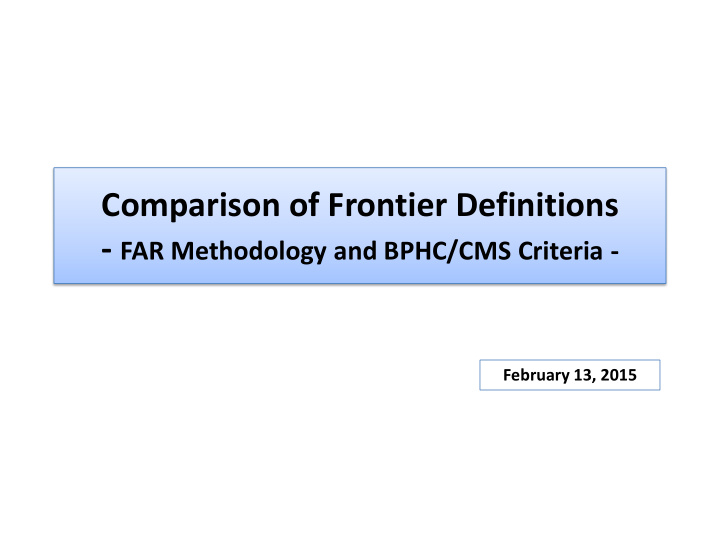



Comparison of Frontier Definitions - FAR Methodology and BPHC/CMS Criteria - February 13, 2015
Three Alternative Frontier Definitions • FAR Methodology: The FAR methodology is a based upon distance/travel time between rural areas and urbanized areas. – FAR areas are defined at a .5 KM square grid level. – These grids can be aggregated, based on formula, at a multi-grid level, including Census Tracts, Zip Codes, ZCTAs and Counties. • BPHC Criterion: BPHC uses a population density criterion to identify Frontier service areas eligible for funding priority. – Frontier is identified as any service area with a population density no greater than 7 persons per square mile. – Service areas can be constructed from Census Tracts, ZCTAs, Counties or other appropriate Census subdivisions. • CMS Super Rural: CMS identifies rural Zip Codes with the lowest population density as Super Rural. CMS selects the bottom quartile of rural Zip Codes for this designation. Payment bonuses are contingent on this designation.
Maps Included for Comparison • FAR Maps: The following maps present FAR Level 1 identified areas for the 48 contiguous US states, compiled at the Zip Code level. FAR maps based on the Year 2000 and Year 2010 Census are included. • BPHC Criterion Maps: For comparison, maps using the BPHC Frontier Criterion are presented, with potentially eligible areas at the Census Tract and County levels identified. • CMS Super Rural Map: For additional comparison, a map of eligible locations for the CMS Super Rural payment differential is presented.
Frontier and Remote (FAR) Areas, Level 1 2000 FAR level one includes ZIP Code areas with majority populations living 60 minutes or more from urban areas of 50,000 or more people. FAR Not FAR
Frontier and Remote (FAR) Areas, Level 1 2010 FAR level one includes ZIP Code areas with majority populations living 60 minutes or more FAR from urban areas of 50,000 or more people. Not FAR New Urbanized Areas in 2010 that significantly affect FAR status
Some Preliminary Observations • BPHC County Map: Counties meeting the BPHC criterion cover an area similar to those identified by the FAR methodology as aggregated to the Zip Code level. The FAR maps show more designated areas in Midwest and Eastern states. The BPHC county map shows more designated areas in the Texas panhandle. • BPHC Census Tract Map: Census Tracts meeting the BPHC criterion show significantly more areas as frontier than does the FAR Zip Code map. It is similar to the FAR grid level map, but does not include many areas in the Eastern states. • CMS Super Rural Map: This map identifies the greatest number of areas as frontier, including some in Eastern and Midwest states.
Recommend
More recommend